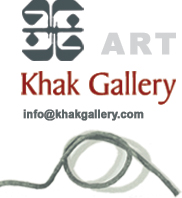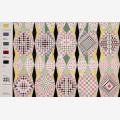
#1 Jila Alley, Basiri St. Gholhak
Shariati Ave. IRAN TEHRAN
TEL: (0098-21) 22 60 54 65
I Will Make A City Interconnected by Cul-de-Sacs ( فارسی )
SEND TO A FRIEND!Writen By
Square, can be signified as a balanced, strong shape and a symbol of masculinity, earth, strength, stability and logic. Square in Persian culture and architecture plays a significant role and it can be seen as an expression of classical elements: earth, fire, air and water and also cardinal directions. Plato defines square as a beautiful shape and a symbol of eternity.
In Nargess Hashemi’s oeuvres, squares can be seen numerously. These squares primarily were created as a result of her doodles and now they have been created for a bigger intention, this intention made them to have characters, so the viewers can easily find themselves among the squares. Graph papers can be seen as a symbol of regulation, interference of the vertical and horizontal lines which leads them to create 25 mm squares is a logical result of this regulation which creates a base that is both regular and flexible. These squares get bigger or smaller, they turn into different geometrical shapes, sometimes they turn into a texture and sometimes the own their specific character. Sometimes in their 2 dimensional base they seem like the shape that exist in islamic architecture and make us to wander around in these mysterious squares. This time in her paintings, each square can be considered as a space, each square with its specific color is introducing a specific part of the city: Orange is medical services, purple is high tech transportation, black symbolizes the voids, yellow is solar energy facilities, green is green spaces, brown is ecological study center, blue is water features an facilities and red symbolizes the cultural and educational centers.
One of the interesting features of these spaces is the importance of green spaces and protecting the environment; in this city, vehicles have to get reduced because there are numerous cul-de-sacs. Also the usage of solar energy facilities has made the city both environment friendly and a proper place to live.
Hence, Nargess Hashemi’s works depict her ideal spaces — as always mixed with the sense of sincerity, security, closeness which gives us the warmth feeling that we sense in our family. Although they seem like a utopian environment they are not unreachable and this matter makes us think about the negative effects of the post-modern architecture and society. Insensibility and seclusion are two almost hidden diagnostics of this style of architecture that brings insecureness to citizens. Nargess’s sensibility and awareness about her surroundings caused her to alternate the spaces that we always go through them and affect us but we never think of them so deeply to change them ourselves.
Picasso used to see everything as cubes in his cubism period, also Nargess sees everything as squares, hence, her oeuvres can be categorized in 3 scales:
1.Smaller construction and complexes seen from 100 meters, show smaller places dedicated to specific groups and services, such as a rehabilitation center, with high tech transport, a cultural unit and powered by solar energy, that involves its inmates in ecological studies, therefore creating a space that moves towards a better future both internally and externally. 2. Spaces from 500 meters and showing bigger complexes and small towns, like a town built for people who make handicraft, with cultural and educational spaces dedicated to their practice and homes that allows for them to live near their workspace and in their own community.
3. Cities seen from 5 km, made
for larger crowds of mixed people. Such as a city fully dedicated to marine conservation and
people who are involved in working with that industry, from fishermen to farmers and
researchers. A place that provides everyone with the same quality of life and concentrates all
services in one place to create a more sustainable and practical work and life environment.
“Family” has always been present significantly in Nargess Hashemi’s work, as a reference we can look through her earliest work that depicted family scenes, artworks which show the sincerity and sympathy in her own family and also small family gatherings. Also in her latest works which include a crochet sculpture that divides space into different parts, are made with the assistance of her family members. This time we do not see her family members depicted as a painting but we see what has come as a result of the endeavors shown in the previous works. Whirling of colors, just the phenomena that happens in an expressionism painting on a canvas, is one of the Nargess’s ingenuities in this exhibition. The negative spaces and colored ones, the movement existing in the still sculpture that seems infinite are an amazing mixture to experience in an exhibition.
Along with this movement and whirling of colors, silence or to be precise “voids” plays an important role in this exhibition, the empty space are the place which the view stands and observes the oeuvres. In other view we can compare this installation to life, allover the installation is full of beautiful elements but be we stand in the places which are considered as “voids”, where artworks just like our family comfy us but we also have our own place with its specific calmness, just like an ideal way of living.

